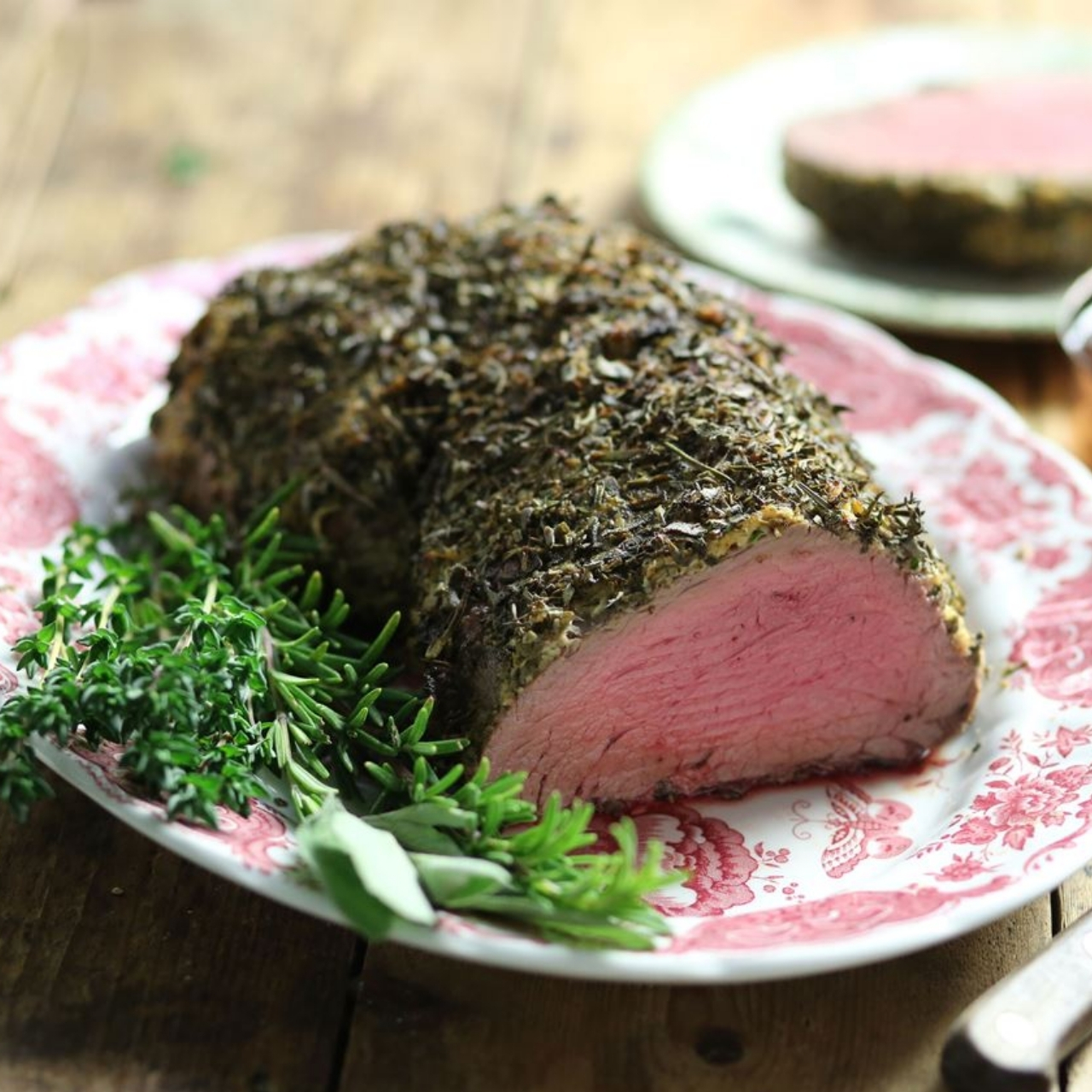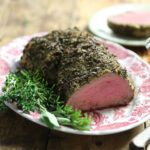Introduction
Detailed Ingredients
- Beef Fillet: 3 lbs, trimmed
- Olive Oil: 2 tablespoons
- Kosher Salt: 2 teaspoons
- Freshly Ground Black Pepper: 1 teaspoon
- Fresh Rosemary: 2 tablespoons, chopped
- Fresh Thyme: 2 tablespoons, chopped
- Garlic: 4 cloves, minced
- Dijon Mustard: 1 tablespoon
- Prep Time: 15 minutes
- Cook Time: 45-55 minutes
- Total Time: 1 hour 10 minutes
- Yield: Serves 8
Detailed Directions and Instructions
Preheat the Oven
Begin by preheating your oven to 400°F (200°C). This step ensures that your oven is at the perfect temperature for roasting, resulting in an evenly cooked beef fillet.
Season the Beef Fillet
Rub the beef fillet with olive oil, then generously season it with kosher salt and freshly ground black pepper. This will form the foundation for the robust flavor profile of your dish.
Prepare the Herb Paste
In a small bowl, mix together the fresh rosemary, thyme, minced garlic, and Dijon mustard to create an aromatic herb paste. This mixture will add depth and complexity to your beef fillet.
Coat the Beef with Herb Paste
Generously coat the entire surface of the beef fillet with the herb paste. Press the mixture onto the meat to ensure full coverage, embedding the vibrant flavors deep into the beef.
Roast the Beef Fillet
Place the seasoned beef on a roasting rack situated in a baking dish. Roast in the preheated oven for approximately 45-55 minutes, or until an internal thermometer reads 130°F (54°C) for medium-rare doneness.
Rest the Beef
Once the beef has completed cooking, remove it from the oven and let it rest for 10 minutes. This crucial step allows the juices to redistribute throughout the meat, enhancing both flavor and tenderness.
Slice and Serve
After resting, slice the beef fillet into thick, succulent medallions and serve immediately. This dish is perfect for a lavish dining experience that is sure to impress your guests.
Notes
Choosing the Right Cut of Beef
Understanding Cooking Times
The cooking time for a beef fillet can vary based on its thickness and your preferred level of doneness. Using a meat thermometer is an excellent way to ensure your beef is cooked to perfection, as it allows you to monitor the internal temperature without guesswork.
Adjusting Herb Mixtures
Feel free to experiment with different herb combinations to adjust the flavor profile according to your preferences. While rosemary and thyme provide classic and complimentary flavors, you can incorporate herbs like sage, oregano, or tarragon for a unique twist on the traditional recipe.
Importance of Resting Time
Resting the beef after roasting is an essential step that is often overlooked. Allowing the beef fillet to rest ensures that the juices are evenly distributed and reabsorbed into the meat. This not only enhances tenderness but also enriches the flavor, giving the beef a more juicy and savory finish.
Serving Suggestions
This oven-roasted herb-crusted beef fillet pairs wonderfully with a variety of side dishes. Consider serving it with roasted vegetables, a fresh green salad, or creamy mashed potatoes to complement the savory flavors of the beef. Additionally, a red wine sauce or a pot of horseradish cream can add a delightful accent to the meal.
Cook Techniques
Roasting
Roasting is a method that uses dry heat, where hot air envelops the food, cooking it evenly on all sides. A high-temperature roast is crucial for achieving that desirable crispy crust while keeping the beef tender and juicy inside.
Herb-Crusting
Herb-crusting involves coating the beef with a mixture of herbs and seasonings. This technique imparts intense flavor and creates a delightful textural contrast. The herb paste serves as a barrier, keeping the moisture within the beef while infusing it with herbal notes.
Resting Meat
Allowing meat to rest post-cooking is essential to the overall texture and flavor. During resting, the fibers of the beef relax and reabsorb the juices that were expelled during cooking. This process guarantees a succulent, mouthwatering cut of beef.
Enhancing Your Cooking Experience
The Role of Herbs in Beef Cuisine
Herbs play a pivotal role in elevating the flavor of beef dishes. In this recipe, the combination of rosemary and thyme brings a fragrant earthiness to the fillet, complementing the succulent beef without overpowering its natural flavors. Each herb contributes uniquely: rosemary offers a woody aroma and peppery taste, while thyme introduces subtle floral notes. This delicate harmony creates an inviting and tantalizing aroma, inviting your senses to delve into a well-considered culinary journey.
Why Olive Oil is Essential
Olive oil acts as more than just a lubricant for your beef fillet; it is an integral part of the flavor and texture. When rubbed onto the surface, it aids in the even distribution of seasoning and forms a protective layer that helps brown the beef during roasting. The slightly fruity, pungent flavor of olive oil complements the robust taste of the beef and the aromatics of the herbs, producing a beautifully balanced dish that delights the palate.
The Importance of Serving Temperature
Serving temperature is key to ensuring your herb-crusted beef fillet is enjoyed to its fullest. After letting the beef rest, it is recommended to slice and serve immediately to maintain optimal warmth. Enjoying the beef at the right temperature enhances its flavor profile and mouthfeel, making it tender and juicy, and maximizing the sensory pleasure of your dining experience. Prepared and presented well, this dish easily becomes the centerpiece of any meal.
Tips for a Perfect Herb-Crusted Beef Fillet
To achieve the perfect herb-crusted beef fillet, begin by ensuring the fillet is at room temperature before roasting. This step promotes even cooking. While applying the herb paste, make sure to cover all sides generously for a rich flavor encasement. Using a thermometer helps monitor the internal temperature for your desired doneness, allowing precise control. Finally, prioritize resting time to ensure the beef retains its juices and flavors for a truly memorable dining experience.
FAQ
What is the best cut of beef for this recipe?
The beef fillet is ideal for this recipe due to its tender texture and ability to absorb flavors well. Known for its tenderness, the fillet is a premium choice that ensures your dish comes out succulent and flavorful.
How can I tell when the fillet is cooked to medium-rare?
Using a meat thermometer is the most reliable way to determine doneness. For medium-rare, the internal temperature should read 130°F (54°C) when inserted into the thickest part of the fillet.
Are there alternative herbes I can use?
Yes, you can experiment with various herbs such as sage, oregano, or tarragon to suit your taste preference. Each herb offers a unique flavor profile, so feel free to mix and match for a personalized touch.
Why is resting the beef important?
Resting the beef is crucial because it allows the juices to redistribute throughout the fillet, making it juicier and more flavorful. Skipping this step can result in a dry and less flavorful dish.
Can I prepare the herb paste in advance?
Certainly! You can prepare the herb paste a day in advance and store it in the refrigerator. This can save time on the day of cooking and even enhance the flavors as they meld together.
What are some recommended sides for this dish?
Consider pairing the herb-crusted beef fillet with creamy mashed potatoes, roasted vegetables, or a fresh green salad. These sides complement the beef’s rich flavors and provide a well-rounded meal.
Conclusion
More Recipes Suggestions and Combinations
Garlic Butter Roasted Potatoes
Enhance your beef fillet with a side of garlic butter roasted potatoes. The soft, buttery potatoes paired with garlic create a perfect accompaniment to the beef’s savory profile.
Classic Caesar Salad
A classic Caesar salad complements the richness of the beef fillet. The crisp romaine lettuce, Parmesan cheese, and tangy Caesar dressing provide a refreshing balance to the main dish.
Red Wine Reduction Sauce
Consider making a sumptuous red wine reduction sauce. This sauce adds depth and richness, beautifully pairing with the herb-crusted fillet and enhancing the overall flavor profile of your meal.
Steamed Asparagus with Lemon
Steamed asparagus with a hint of lemon offers a vibrant and fresh side that brightens the meal. Its simplicity and flavor perfectly balance the richness of the beef fillet.
PrintOven-Roasted Herb-Crusted Beef Fillet
Treat yourself to a gourmet experience with our Oven-Roasted Herb-Crusted Beef Fillet. Perfect for any special occasion or a cozy dinner at home, this dish is sure to impress. Roasted to perfection, the beef fillet is infused with aromatic herbs that blend beautifully with its rich, savory flavor. Follow this recipe to enjoy a restaurant-quality meal right in your kitchen, making every bite truly unforgettable.
- Prep Time: 15 minutes
- Cook Time: 45-55 minutes
- Total Time: 1 hour 10 minutes
- Yield: Serves 8
Ingredients
- Beef Fillet: 3 lbs, trimmed
- Olive Oil: 2 tablespoons
- Kosher Salt: 2 teaspoons
- Freshly Ground Black Pepper: 1 teaspoon
- Fresh Rosemary: 2 tablespoons, chopped
- Fresh Thyme: 2 tablespoons, chopped
- Garlic: 4 cloves, minced
- Dijon Mustard: 1 tablespoon
Instructions
Preheat the Oven
Begin by preheating your oven to 400°F (200°C). This step ensures that your oven is at the perfect temperature for roasting, resulting in an evenly cooked beef fillet.
Season the Beef Fillet
Rub the beef fillet with olive oil, then generously season it with kosher salt and freshly ground black pepper. This will form the foundation for the robust flavor profile of your dish.
Prepare the Herb Paste
In a small bowl, mix together the fresh rosemary, thyme, minced garlic, and Dijon mustard to create an aromatic herb paste. This mixture will add depth and complexity to your beef fillet.
Coat the Beef with Herb Paste
Generously coat the entire surface of the beef fillet with the herb paste. Press the mixture onto the meat to ensure full coverage, embedding the vibrant flavors deep into the beef.
Roast the Beef Fillet
Place the seasoned beef on a roasting rack situated in a baking dish. Roast in the preheated oven for approximately 45-55 minutes, or until an internal thermometer reads 130°F (54°C) for medium-rare doneness.
Rest the Beef
Once the beef has completed cooking, remove it from the oven and let it rest for 10 minutes. This crucial step allows the juices to redistribute throughout the meat, enhancing both flavor and tenderness.
Slice and Serve
After resting, slice the beef fillet into thick, succulent medallions and serve immediately. This dish is perfect for a lavish dining experience that is sure to impress your guests.
Notes
Choosing the Right Cut of Beef
Understanding Cooking Times
The cooking time for a beef fillet can vary based on its thickness and your preferred level of doneness. Using a meat thermometer is an excellent way to ensure your beef is cooked to perfection, as it allows you to monitor the internal temperature without guesswork.
Adjusting Herb Mixtures
Feel free to experiment with different herb combinations to adjust the flavor profile according to your preferences. While rosemary and thyme provide classic and complimentary flavors, you can incorporate herbs like sage, oregano, or tarragon for a unique twist on the traditional recipe.
Importance of Resting Time
Resting the beef after roasting is an essential step that is often overlooked. Allowing the beef fillet to rest ensures that the juices are evenly distributed and reabsorbed into the meat. This not only enhances tenderness but also enriches the flavor, giving the beef a more juicy and savory finish.
Serving Suggestions
This oven-roasted herb-crusted beef fillet pairs wonderfully with a variety of side dishes. Consider serving it with roasted vegetables, a fresh green salad, or creamy mashed potatoes to complement the savory flavors of the beef. Additionally, a red wine sauce or a pot of horseradish cream can add a delightful accent to the meal.


